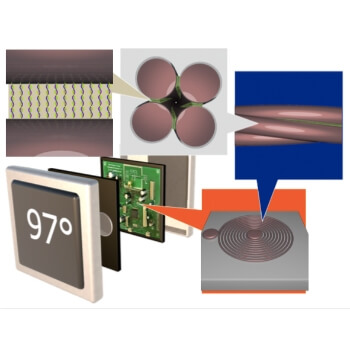News
Harvard and Draper¹s NanoLitz approach braids microscopic wires to reduce heat loss, improve efficiency, and sharpen filter response. Credit: Draper
(CAMBRIDGE, Mass.) – With vehicles communicating with embedded monitors alongside roadways to better route traffic, and home appliances connected to the smart grid to improve efficiency and reliability, the Internet of Things (IOT) may generate more than $14 trillion in economic activity by 2025. However, the concept cannot fully take off without sufficient frequency spectrum to connect the assorted devices. Many in industry believe that significant policy changes will be required to enable the needed connections while avoiding interference.
Researchers at the Harvard John A. Paulson School of Engineering and Applied Sciences (SEAS) and Draper are developing a new approach to assembling nanoscale hardware that could overcome this challenge by enabling devices to generate and receive purer signals to reduce interference with other nearby transmissions. This could free up spectrum by reducing the need for space between frequencies that the Federal Communications Commission now assigns to different users, explained Draper’s Amy Duwel, technical director for the NanoLitz project.
The Defense Advanced Research Projects Agency (DARPA) and the U.S. Air Force Research Laboratory are funding the NanoLitz work as part of the Atoms to Product (A2P) effort to find new ways to assemble nanoscale materials that cannot be accomplished with current techniques such as those used in the semiconductor and microelectromechanical systems (MEMS) industries or through chemical synthesis. The results could be applied to tools that enable humans to scale sheer walls; stealth technology; and ultra-small position, navigation and timing devices.
The NanoLitz approach braids microscopic wires to reduce heat loss, improve efficiency, and sharpen filter response. To operate at frequencies used in devices like smartphones, Roy Gordon, Thomas Dudley Cabot Professor of Chemistry and Professor of Materials Science at Harvard, is developing techniques for making wires up to 1,000 times smaller than those used today. The wires will be braided with techniques borrowed from MEMS and microfluidics. The team is also developing a DNA self-assembly method as a tool for manufacturing braids. That work is led by Vinothan Manoharan, Wagner Family Professor of Chemical Engineering and Professor of Physics; and Michael Brenner, Glover Professor of Applied Mathematics and Applied Physics and Professor of Physics, both at Harvard SEAS.
In parallel, Draper is developing a microfluidics-inspired approach for mechanically braiding the tiny wires that would be scalable to large numbers of wire at high throughput. Draper is also leading the efforts to model and design the Nanolitz wire to optimize electrical performance.
The improved signal performance could also enable devices to transmit up to five times more data per channel, receive much fainter signal levels, and overcome interference that disrupts GPS signals, said Draper’s David Carter, NanoLitz program manager.
The project builds on Draper’s expertise in harnessing advanced materials to develop biomedical solutions as well as systems like miniature communications and navigation devices.
Draper
As a not-for-profit research and development company, Draper focuses on the design, development and deployment of advanced technological solutions for the world’s most challenging and important problems. We provide engineering services directly to government, industry, and academia; work on teams as prime contractor or subcontractor; and participate as a collaborator in consortia. We provide unbiased assessments of technology or systems designed or recommended by other organizations — custom designed, as well as commercial-off-the-shelf.
Harvard Paulson School
The Harvard John A. Paulson School of Engineering and Applied Sciences (SEAS) serves as the connector and integrator of Harvard’s teaching and research efforts in engineering, applied sciences, and technology. Through collaboration with researchers from all parts of Harvard, other universities, and corporate and foundational partners, we bring discovery and innovation directly to bear on improving human life and society.
Cutting-edge science delivered direct to your inbox.
Join the Harvard SEAS mailing list.
Press Contact
Paul Karoff
